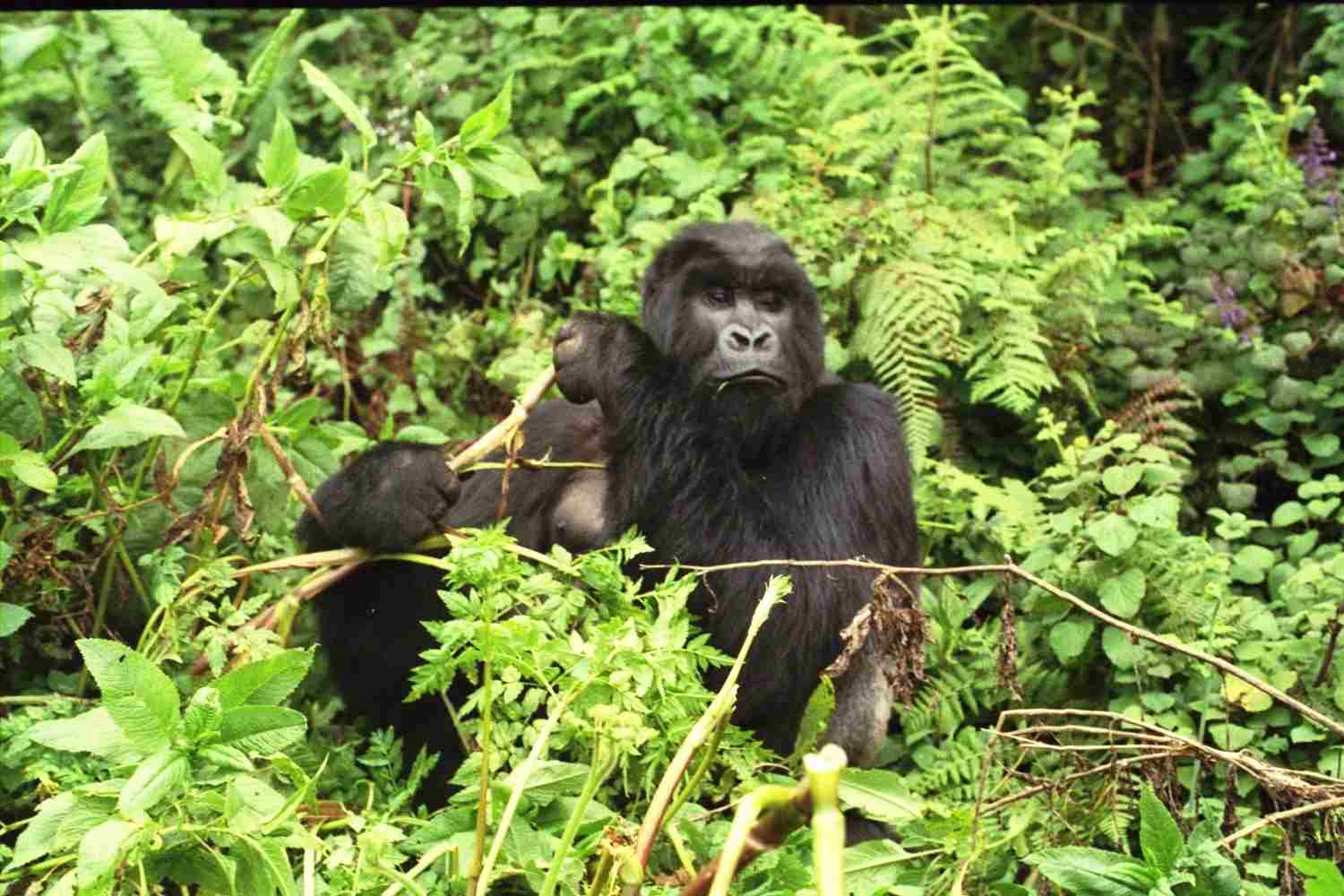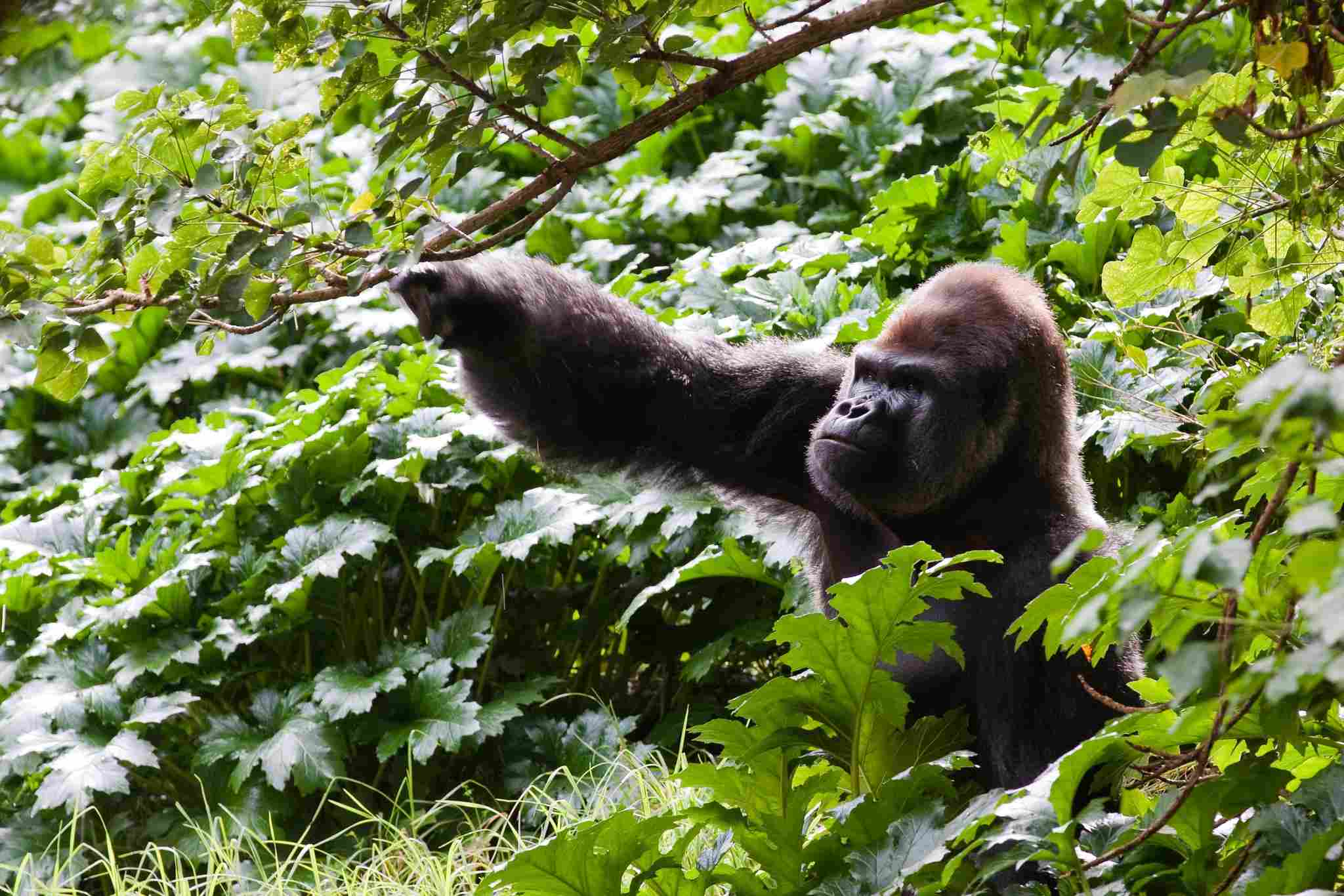Gorilla Vs Elephant Who Would Win, and Overall Comparison
Gorillas and elephants, each iconic in their own right, embody unique characteristics within the animal kingdom. Gorillas, known for their strength, thrive in dense forests, while elephants, as the largest land mammals, command respect in various habitats. This analysis delves into taxonomy, appearance, size, weight, and strength to assess the potential outcome of a one-on-one confrontation between a gorilla and an elephant.
Gorilla vs Elephant: Who Will Win in a Fight/Physical Confrontation?
In a one-on-one confrontation, a lone elephant is undoubtedly expected to overpower a solitary gorilla due to its vastly larger size, greater weight, and superior strength.
I). Size and Weight Advantage:
– Elephants, being the largest land mammals, hold an overwhelming advantage in size and weight over gorillas. This significant difference establishes a decisive upper hand in confrontational scenarios.

II). Strength Advantage:
– The sheer strength of elephants far surpasses that of gorillas, providing them with the physical power needed to easily dominate in one-on-one confrontations.
III). Physical Dominance:
– The physical dominance of elephants, marked by their massive size and strength, creates an insurmountable barrier for gorillas, limiting their ability to pose a significant threat.
While gorillas are strong within their ecological niche, they lack the physical attributes to compete with the immense size and strength of an elephant.
*Details of Comparison
| Aspect | Gorilla | Elephant |
| Taxonomy | Family: Hominidae |
Family: Elephantidae
|
| Genus: Gorilla |
Genus: Elephas (Asian), Loxodonta (African)
|
|
| Species: Gorilla beringei (Eastern Gorilla), Gorilla gorilla (Western Gorilla) |
Species: Elephas maximus (Asian), Loxodonta africana (African)
|
|
| Appearance | Robust build, dark fur, prominent brow ridge |
Large, grayish skin, elongated trunk, large ears
|
| Size | Males: 5.6-5.9 ft, Females: Smaller |
Asian Elephants: 6.6-9.8 ft, African Elephants: 8.2-13 ft
|
| Weight | Males: 300-440 lbs, Females: Smaller |
Asian Elephants: 4,500-11,000 lbs, African Elephants: 5,000-14,000 lbs
|
| Bite Force | ~1,300 psi |
Difficult to measure accurately, relatively lower
|
| Physical Offensive Advantages | Arm strength, large canines |
Size, tusks, versatile trunk
|
| Physical Defensive Advantages | Muscular build, social structure |
Thick skin, tusks, trunk
|
| Speed | ~20 mph |
African Elephants: Up to 25 mph, Asian Elephants: Slightly slower
|
| Agility | Agile in trees and on the ground |
Surprising agility for size
|
| Overall Physical Capacity | Climbing, brachiation, muscular strength |
Strength, endurance, long-distance travel
|
| Habitat Preference(s) | Dense tropical forests |
Diverse, from dense forests to savannas
|
| Tracks | Hands and feet with opposable big toes |
Large, rounded tracks with visible toenails
|
| Lifespan | Wild: 35-40 years, Captive: >50 years |
African Elephants: 60-70 years, Asian Elephants: 60-75 years
|
| Mode of Feeding | Herbivores, leaves, fruits, occasional insects |
Herbivores, grasses, leaves, bark
|
| Social Behavior | Stable family groups, silverback leader |
Complex social structures, matriarchal groups
|
| Mode of Reproduction | Polygamous mating, single offspring, 8.5 months gestation |
Mating within herds, longer 22 months gestation
|
| Parental Behavior | Strong maternal care, silverback protection |
Intensive maternal care, matriarchal guidance
|
| Proximity to Human Areas | Remote areas, increasing encroachment threats |
Wilderness to human settlements, potential conflicts
|
| Behavior Toward Humans | Shy, avoidant, defensive if threatened |
Variable responses, defensive behavior possible
|
| Danger Posed to Humans | Rarely dangerous, defensive behavior possible |
Potentially dangerous, responsible for more fatalities
|
| Associated Precautions | Habituation programs, strict guidelines |
Awareness programs, strategies to mitigate conflicts
|
| Conservation Status | Eastern Gorilla: Endangered, Western Gorilla: Endangered |
African Elephant: Vulnerable, Asian Elephant: Endangered
|
| Conclusion | Keystone species, face conservation challenges |
Keystone species, varying degrees of vulnerability
|
Key Points
Size and Weight:
Elephants significantly larger and heavier than gorillas.
Physical Traits:
Gorillas possess pronounced bite force and strong arm muscles.
Elephants rely on their immense size, tusks, and versatile trunk.
Ecological Roles:
Both species are keystone, shaping their ecosystems.
Gorillas primarily impact forested habitats, while elephants exhibit a broader range.
Habitat and Tracks:
Gorillas thrive in dense tropical forests.
Elephants inhabit diverse environments, leaving distinctive tracks.
Social Structure:
Gorillas have stable family groups led by a silverback.
Elephants exhibit complex social structures, often matriarchal.
Reproductive Strategies:
Gorillas have a polygamous mating system with shorter gestation.
Elephants mate within herds, with a longer gestation period.
Conservation Status:
Gorillas and elephants face conservation challenges.
Gorillas are endangered, while elephants are vulnerable or endangered.
Human Interaction:
Gorillas are generally shy and avoidant.
Elephants, due to their size, can pose dangers, leading to human-elephant conflicts.
Precautions and Conservation:
Precautions involve habituation programs for gorillas and awareness programs for elephants.
Conservation efforts are critical for both species due to habitat loss and poaching threats.
1. Taxonomy
Gorilla:
Family: Hominidae
Genus: Gorilla
Species: Gorilla beringei (Eastern Gorilla), Gorilla gorilla (Western Gorilla)
Elephant:
Family: Elephantidae
Genus: Elephas (Asian Elephant), Loxodonta (African Elephant)
Species: Elephas maximus (Asian Elephant), Loxodonta africana (African Elephant)
2. Appearance
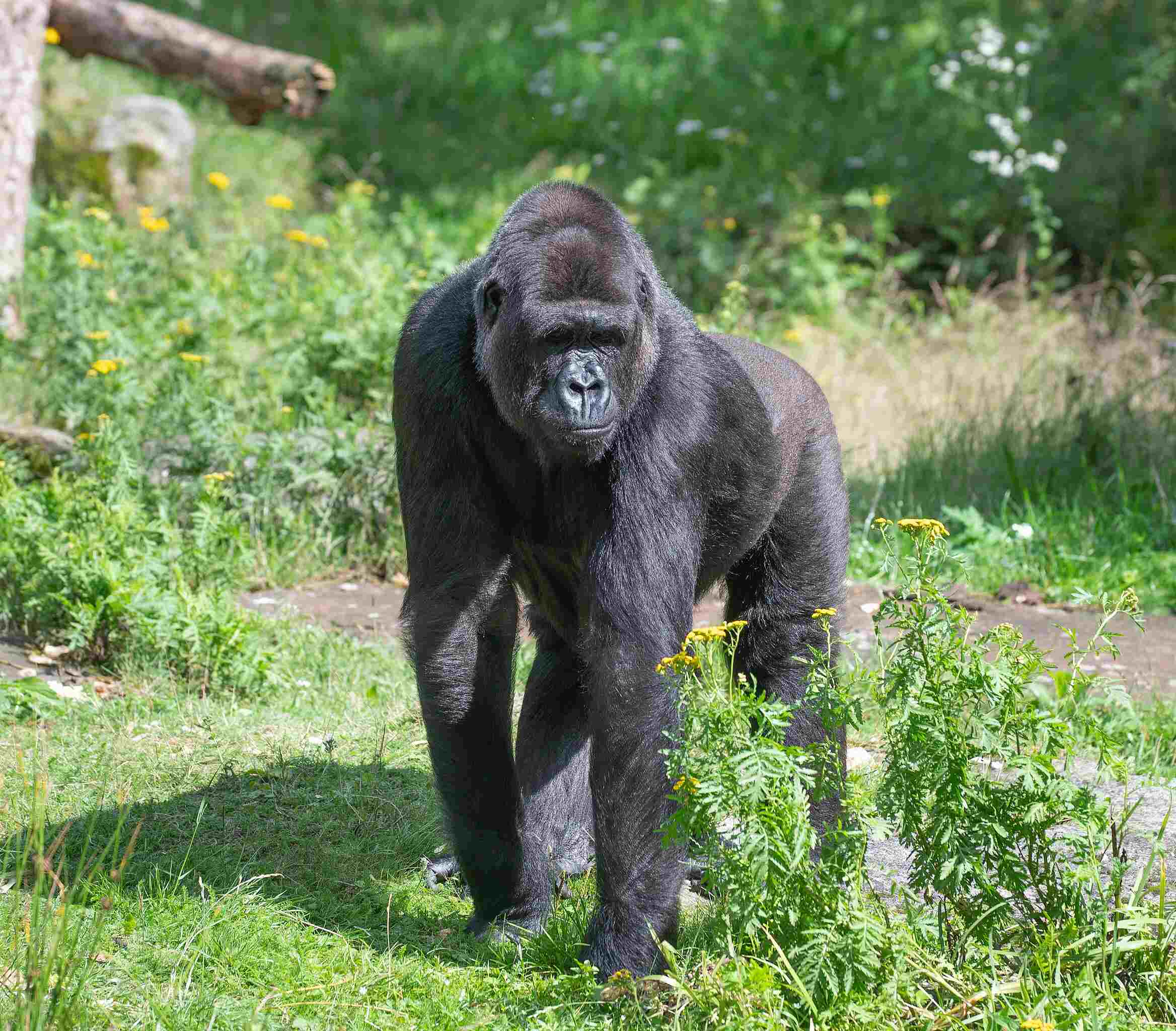
Gorilla:
Robust build with broad shoulders.
Prominent brow ridge and large canine teeth.
Fur covers most of the body, dark in color.
Elephant:
Large, with a distinctive long trunk.
Thick, wrinkled skin, often grayish.
Enormous ears, larger in African elephants.
Comparison:
Gorillas have a more compact, muscular appearance, while elephants are characterized by their massive size and elongated trunk.
Ecological Implications:
Gorilla appearances aid in their arboreal lifestyle, navigating dense vegetation.
Elephant features are adapted for their herbivorous diet, utilizing the trunk for feeding and watering in diverse ecosystems.
3. Size
Gorilla:
Adult males: 5.6 to 5.9 feet (1.7 to 1.8 meters) when standing.
Adult females: Generally smaller than males.
Elephant:
Asian elephants: 6.6 to 9.8 feet (2 to 3 meters) at the shoulder.
African elephants: 8.2 to 13 feet (2.5 to 4 meters) at the shoulder.
Comparison:
Elephants are significantly larger than gorillas, both in height and overall size.
Ecological Implications:
Size influences the ecological niche and dietary requirements, with elephants being crucial in shaping landscapes through their foraging habits.
4. Weight
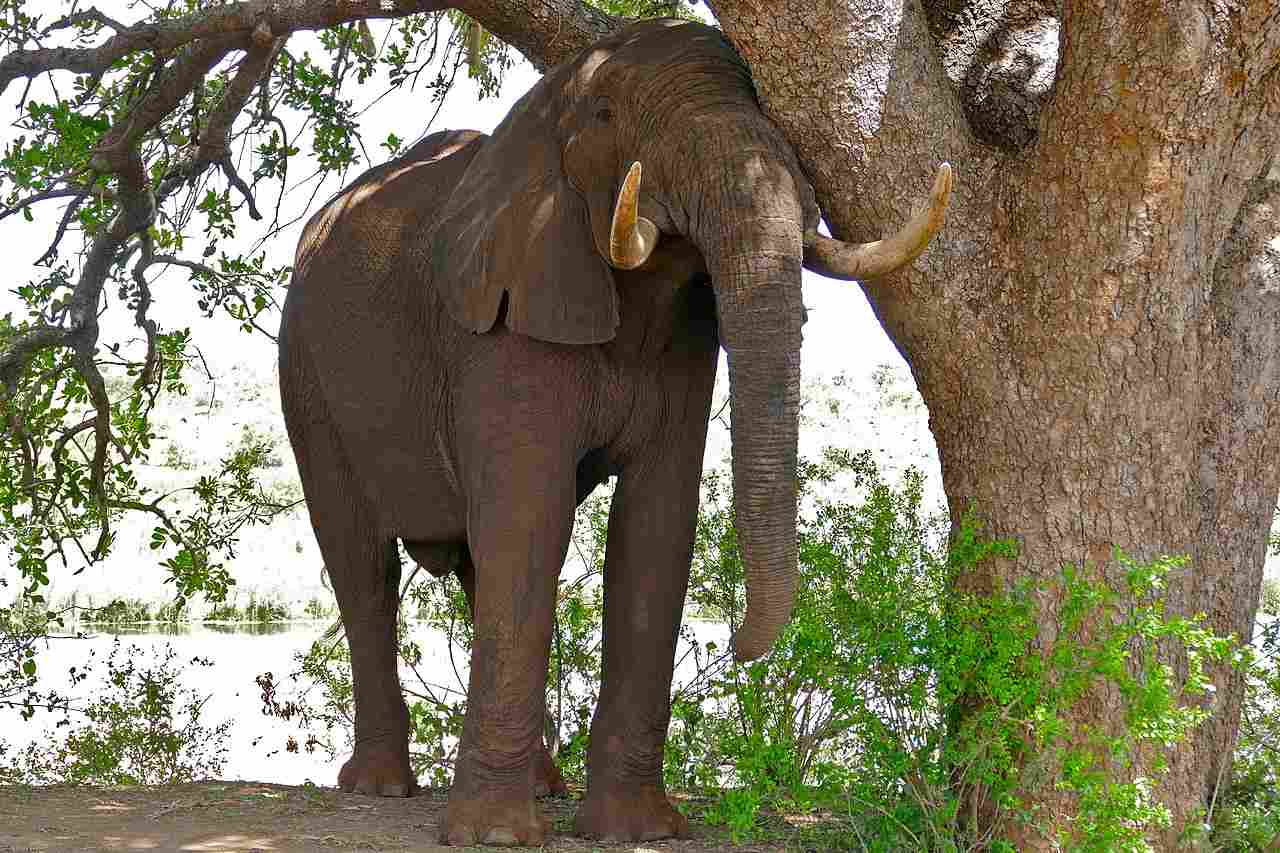
Gorilla:
Adult males: 300 to 440 pounds (136 to 200 kilograms).
Adult females: Generally half the weight of males.
Elephant:
Asian elephants: 4,500 to 11,000 pounds (2,041 to 4,990 kilograms).
African elephants: 5,000 to 14,000 pounds (2,268 to 6,350 kilograms).
Comparison:
Elephants outweigh gorillas by several orders of magnitude.
Ecological Implications:
Weight affects their impact on vegetation, soil compaction, and the overall ecosystem structure.
5. Bite Force
Gorilla:
Estimated at around 1,300 pounds per square inch (psi).
Elephant:
Difficult to measure accurately due to trunk structure, but relatively lower compared to other large mammals.
Comparison:
Gorillas have a more pronounced bite force compared to elephants.
Ecological Implications:
Gorilla bite force is adapted for their omnivorous diet, including tough plant materials and occasional small animals. Elephant reliance on trunk suction and grinding influences their ecological role in seed dispersal.
6. Physical Offensive Advantages
Gorilla:
Powerful arm strength for striking.
Canines used in threat displays.
Elephant:
Enormous size and tusks provide a formidable presence.
Trunk can be used defensively and offensively.
Comparison:
Gorillas rely on physical strength and intimidation, while elephants utilize their sheer size, tusks, and versatile trunks for offense.
Ecological Implications:
These offensive features contribute to maintaining dominance within their respective habitats.
7. Physical Defensive Advantages
Gorilla:
Muscular build offers protection against predators.
Social structure aids in communal defense.
Elephant:
Thick skin acts as a natural armor.
Tusks and trunk can be used for defense.
Comparison:
Gorillas depend on group dynamics and physical prowess for defense, while elephants have a more individualistic approach using their size and physical attributes.
Ecological Implications:
Defensive strategies play a role in the survival and well-being of each species within their ecosystems.
8. Speed
Gorilla:
Average speed of about 20 miles per hour (32 kilometers per hour) in short bursts.
Elephant:
African elephants can reach speeds of up to 25 miles per hour (40 kilometers per hour).
Asian elephants are slightly slower.
Comparison:
Elephants generally have a higher top speed than gorillas.
Ecological Implications:
Speed influences their ability to navigate their habitats, escape threats, and access resources.
9. Agility

Gorilla:
Agile in trees, with arboreal adaptations.
Can move swiftly on the ground, especially in dense vegetation.
Elephant:
Despite their size, elephants display surprising agility, particularly in their ability to navigate varied terrains.
Comparison:
Gorillas showcase agility in both arboreal and terrestrial environments, while elephants demonstrate unexpected agility for their size.
Ecological Implications:
Agility impacts their foraging efficiency, ability to escape predators, and adaptability to changing environments.
10. Overall Physical Capacity
Gorilla:
Adapted for climbing and brachiation.
Well-developed muscles for strength and endurance.
Elephant:
Strong endurance for long-distance travel.
Remarkable physical strength for tasks like digging and pushing down trees.
Comparison:
Gorillas excel in climbing and navigating dense vegetation, while elephants showcase immense strength and endurance.
Ecological Implications:
These physical capacities contribute to the ecological roles of each species, influencing their impact on the environment.
11. Habitat Preference(s)

Gorilla:
Primarily found in dense, tropical forests.
Prefers areas with substantial vegetation cover.
Elephant:
Range from dense forests to savannas and grasslands.
Require access to water sources.
Comparison:
Gorillas are more specialized in forested habitats, while elephants display a broader range of habitat preferences.
Ecological Implications:
Habitat preferences determine the distribution of each species, impacting local ecosystems.
12. Tracks
Gorilla:
Hands and feet with opposable big toes leave distinct tracks.
Often show signs of knuckle-walking.
Elephant:
Large, rounded tracks with visible toenails.
Trunk drags may leave additional marks.
Comparison:
Gorilla tracks reflect their arboreal and terrestrial locomotion, while elephant tracks highlight their massive size and unique foot structure.
Ecological Implications:
Tracking allows researchers to monitor and study the distribution and movements of these species within their habitats.
13. Lifespan
Gorilla:
Wild lifespan: 35-40 years.
Captive lifespan: Can exceed 50 years.
Elephant:
African elephants: 60-70 years.
Asian elephants: 60-75 years.
Comparison:
Elephants generally have a longer lifespan compared to gorillas.
Ecological Implications:
Lifespan influences population dynamics, reproductive strategies, and ecological contributions over time.
14. Mode of Feeding
Gorilla:
Herbivores with a primarily vegetarian diet.
Feeds on leaves, fruits, and occasionally insects.
Elephant:
Herbivores with a preference for grasses, leaves, and bark.
High daily food intake, utilizing their trunk for feeding.
Comparison:
Both species are herbivores, but the specifics of their diets vary.
Ecological Implications:
Feeding habits contribute to shaping vegetation structures and influence the distribution of plant species in their ecosystems.
15. Social Behavior
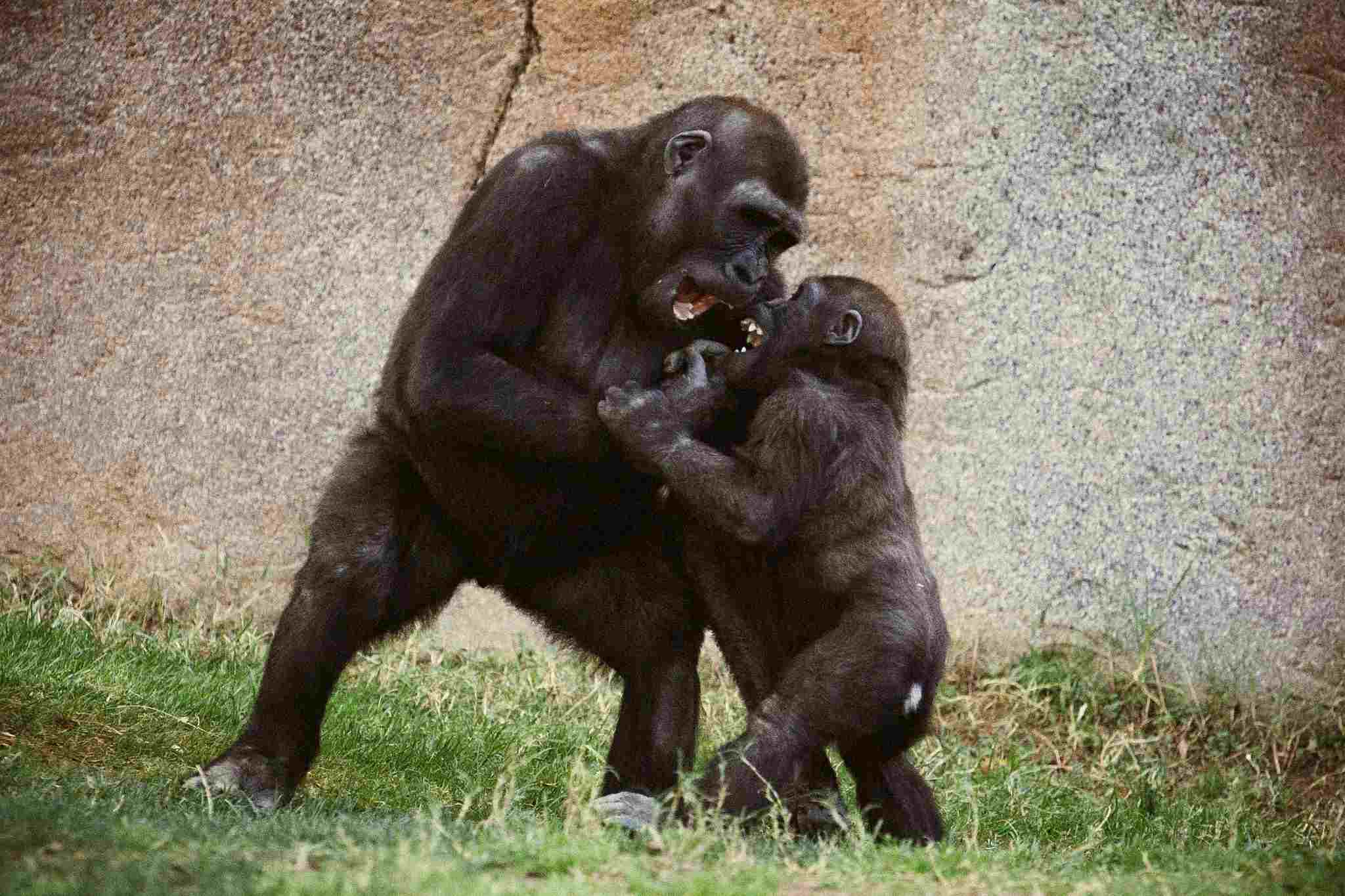
Gorilla:
Live in stable family groups led by a dominant silverback.
Social structure includes females and their offspring.
Elephant:
Complex social structures, often in matriarchal groups.
Strong family bonds and communication.
Comparison:
Both exhibit strong social bonds, but gorillas have a more defined hierarchical structure with a dominant leader.
Ecological Implications:
Social structures impact how these species interact within their environments, affecting behaviors like foraging and reproduction.
16. Mode of Reproduction
Gorilla:
Polygamous mating system.
Females give birth to a single offspring after a gestation period of around 8.5 months.
Elephant:
Mating occurs within a herd.
Longer gestation period, approximately 22 months.
Comparison:
While both species have a social mating system, elephants have a longer gestation period.
Ecological Implications:
Reproductive strategies influence population dynamics, with longer gestation periods impacting birth rates.
17. Parental Behavior
Gorilla:
Strong maternal care.
Silverback provides protection and support for the group.
Elephant:
Intensive maternal care, with strong bonds between mothers and calves.
Matriarchal figure guides the herd.
Comparison:
Both species exhibit strong parental care, contributing to the survival and well-being of offspring.
Ecological Implications:
Parental behaviors influence the stability and resilience of populations within their ecosystems.
18. Proximity to Human-Inhabited Areas
Gorilla:
Found in remote areas of tropical forests.
Increasing human encroachment poses threats to their habitats.
Elephant:
Range from remote wilderness to areas close to human settlements.
Human-elephant conflict arises in regions where their habitats intersect.
Comparison:
Elephants have a higher likelihood of proximity to human-inhabited areas compared to gorillas.
Ecological Implications:
Human presence near these species’ habitats can lead to habitat loss, conflicts, and conservation challenges.
19. Behavior Toward Humans
Gorilla:
Generally shy and avoidant of direct human contact.
May exhibit defensive behavior if they feel threatened.
Elephant:
Responses vary; some may be wary, while others can be aggressive, especially in conflict situations.
Can display defensive behavior to protect themselves or their herd.
Comparison:
Gorillas tend to be more avoidant, while elephants’ reactions can be more variable.
Ecological Implications:
Human interactions can impact stress levels and behaviors in both species, influencing their overall well-being.
20. Danger Posed to Humans
Gorilla:
Rarely pose a direct threat to humans.
Defensive behavior may be exhibited if they perceive a threat.
Elephant:
Can be dangerous, especially during periods of stress or if they feel threatened.
Responsible for more human fatalities than gorillas.
Comparison:
Elephants, due to their
*Summary of Comparison
Taxonomy
Gorilla: Family Hominidae, Genus Gorilla, Species Gorilla beringei (Eastern Gorilla), Gorilla gorilla (Western Gorilla)
Elephant: Family Elephantidae, Genus Elephas (Asian Elephant), Loxodonta (African Elephant), Species Elephas maximus (Asian Elephant), Loxodonta africana (African Elephant)
Appearance
Gorilla: Robust build, dark fur, prominent brow ridge.
Elephant: Large, grayish skin, elongated trunk, large ears.
Size
Gorilla: Males 5.6-5.9 ft, Females smaller.
Elephant: Asian Elephants 6.6-9.8 ft, African Elephants 8.2-13 ft.
Weight
Gorilla: Males 300-440 lbs, Females smaller.
Elephant: Asian Elephants 4,500-11,000 lbs, African Elephants 5,000-14,000 lbs.
Bite Force
Gorilla: ~1,300 psi.
Elephant: Difficult to measure accurately, relatively lower.
Physical Offensive Advantages
Gorilla: Arm strength, large canines.
Elephant: Size, tusks, versatile trunk.
Physical Defensive Advantages
Gorilla: Muscular build, social structure.
Elephant: Thick skin, tusks, trunk.
Speed
Gorilla: ~20 mph.
Elephant: African Elephants up to 25 mph, Asian Elephants slightly slower.
Agility
Gorilla: Agile in trees and on the ground.
Elephant: Surprising agility for size.
Overall Physical Capacity
Gorilla: Climbing, brachiation, muscular strength.
Elephant: Strength, endurance, long-distance travel.
Habitat Preference(s)
Gorilla: Dense tropical forests.
Elephant: Diverse, from dense forests to savannas.
Tracks
Gorilla: Hands and feet with opposable big toes.
Elephant: Large, rounded tracks with visible toenails.
Lifespan
Gorilla: Wild 35-40 years, Captive >50 years.
Elephant: African Elephants 60-70 years, Asian Elephants 60-75 years.
Mode of Feeding
Gorilla: Herbivores, leaves, fruits, occasional insects.
Elephant: Herbivores, grasses, leaves, bark.
Social Behavior
Gorilla: Stable family groups, silverback leader.
Elephant: Complex social structures, matriarchal groups.
Mode of Reproduction
Gorilla: Polygamous mating, single offspring, 8.5 months gestation.
Elephant: Mating within herds, longer 22 months gestation.
Parental Behavior
Gorilla: Strong maternal care, silverback protection.
Elephant: Intensive maternal care, matriarchal guidance.
Proximity to Human Areas
Gorilla: Remote areas, increasing encroachment threats.
Elephant: Wilderness to human settlements, potential conflicts.
Behavior Toward Humans
Gorilla: Shy, avoidant, defensive if threatened.
Elephant: Variable responses, defensive behavior possible.
Danger Posed to Humans
Gorilla: Rarely dangerous, defensive behavior possible.
Elephant: Potentially dangerous, responsible for more fatalities.
Associated Precautions
Gorilla: Habituation programs, strict guidelines.
Elephant: Awareness programs, strategies to mitigate conflicts.
Conservation Status
Gorilla: Eastern Gorilla Endangered, Western Gorilla Endangered.
Elephant: African Elephant Vulnerable, Asian Elephant Endangered.
Human Interaction:
Gorillas are generally shy and avoidant.
Elephants, due to their size, can pose a higher potential danger to humans than gorillas.
Ecological Implications:
Human safety concerns can lead to conflicts and negative perceptions, impacting conservation efforts.
21. Associated Precautions

Gorilla:
Habituation programs in some areas to reduce aggression towards humans.
Strict guidelines for tourism and research to minimize disturbance.
Elephant:
Awareness programs to educate communities about elephant behavior.
Implementation of strategies to mitigate human-elephant conflict, such as using barriers or deterrents.
Comparison:
Precautions aim to mitigate risks and promote coexistence, but strategies differ based on the species’ behaviors.
Ecological Implications:
Effective precautions contribute to the conservation of these species by minimizing negative interactions and fostering harmonious cohabitation.
22. Conservation Status
Gorilla:
Eastern Gorilla (Gorilla beringei): Endangered.
Western Gorilla (Gorilla gorilla): Endangered.
Elephant:
African Elephant (Loxodonta africana): Vulnerable.
Asian Elephant (Elephas maximus): Endangered.
Comparison:
Both species face conservation challenges, with gorillas and elephants having varying degrees of vulnerability.
Ecological Implications:
Conservation efforts are crucial to maintaining biodiversity and ecological balance in regions where these species reside.
*Summary of Comparison
Taxonomy
Gorilla: Family Hominidae, Genus Gorilla, Species Gorilla beringei (Eastern Gorilla), Gorilla gorilla (Western Gorilla)
Elephant: Family Elephantidae, Genus Elephas (Asian Elephant), Loxodonta (African Elephant), Species Elephas maximus (Asian Elephant), Loxodonta africana (African Elephant)
Appearance
Gorilla: Robust build, dark fur, prominent brow ridge.
Elephant: Large, grayish skin, elongated trunk, large ears.
Size
Gorilla: Males 5.6-5.9 ft, Females smaller.
Elephant: Asian Elephants 6.6-9.8 ft, African Elephants 8.2-13 ft.
Weight
Gorilla: Males 300-440 lbs, Females smaller.
Elephant: Asian Elephants 4,500-11,000 lbs, African Elephants 5,000-14,000 lbs.
Bite Force
Gorilla: ~1,300 psi.
Elephant: Difficult to measure accurately, relatively lower.
Physical Offensive Advantages
Gorilla: Arm strength, large canines.
Elephant: Size, tusks, versatile trunk.
Physical Defensive Advantages
Gorilla: Muscular build, social structure.
Elephant: Thick skin, tusks, trunk.
Speed
Gorilla: ~20 mph.
Elephant: African Elephants up to 25 mph, Asian Elephants slightly slower.
Agility
Gorilla: Agile in trees and on the ground.
Elephant: Surprising agility for size.
Overall Physical Capacity
Gorilla: Climbing, brachiation, muscular strength.
Elephant: Strength, endurance, long-distance travel.
Habitat Preference(s)
Gorilla: Dense tropical forests.
Elephant: Diverse, from dense forests to savannas.
Tracks
Gorilla: Hands and feet with opposable big toes.
Elephant: Large, rounded tracks with visible toenails.
Lifespan
Gorilla: Wild 35-40 years, Captive >50 years.
Elephant: African Elephants 60-70 years, Asian Elephants 60-75 years.
Mode of Feeding
Gorilla: Herbivores, leaves, fruits, occasional insects.
Elephant: Herbivores, grasses, leaves, bark.
Social Behavior
Gorilla: Stable family groups, silverback leader.
Elephant: Complex social structures, matriarchal groups.
Mode of Reproduction
Gorilla: Polygamous mating, single offspring, 8.5 months gestation.
Elephant: Mating within herds, longer 22 months gestation.
Parental Behavior
Gorilla: Strong maternal care, silverback protection.
Elephant: Intensive maternal care, matriarchal guidance.
Proximity to Human Areas
Gorilla: Remote areas, increasing encroachment threats.
Elephant: Wilderness to human settlements, potential conflicts.
Behavior Toward Humans
Gorilla: Shy, avoidant, defensive if threatened.
Elephant: Variable responses, defensive behavior possible.
Danger Posed to Humans
Gorilla: Rarely dangerous, defensive behavior possible.
Elephant: Potentially dangerous, responsible for more fatalities.
Associated Precautions
Gorilla: Habituation programs, strict guidelines.
Elephant: Awareness programs, strategies to mitigate conflicts.
Conservation Status
Gorilla: Eastern Gorilla Endangered, Western Gorilla Endangered.
Elephant: African Elephant Vulnerable, Asian Elephant Endangered.
Conclusion
I). Similarities
Both gorillas and elephants are keystone species, playing critical roles in shaping their respective ecosystems.
Human activities, including habitat destruction and poaching, pose significant threats to the survival of both species.
II). Differences
Gorillas are primarily herbivores with a more limited habitat range, emphasizing dense forests.
Elephants are herbivores with a broader habitat range, from savannas to dense forests, and exhibit a wider array of behaviors, including longer gestation periods and more complex social structures.

